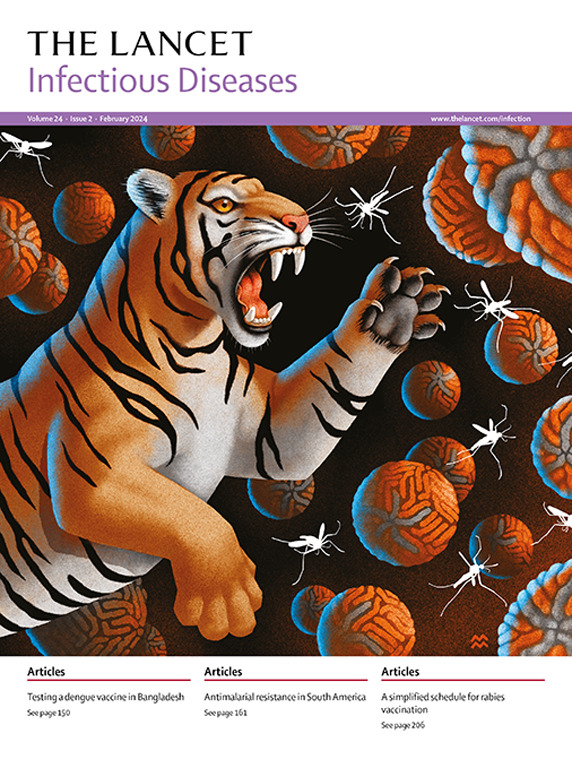Effect of JYNNEOS vaccination on mpox clinical progression: a case–control study
IF 36.4
1区 医学
Q1 INFECTIOUS DISEASES
引用次数: 0
Abstract
Background
The JYNNEOS modified vaccinia virus Ankara vaccine is effective in preventing clade IIb mpox disease. However, vaccine effects on mpox severity are poorly understood. We aimed to assess associations between reported clinical characteristics and vaccination status among individuals with laboratory-confirmed mpox.Methods
We conducted a case–control study using data collected from public health surveillance interviews of people with mpox in California. Eligible participants for primary analyses were men who were cisgender and participated in telephone interviews with complete responses recorded about anatomical sites where they had lesions. We estimated JYNNEOS vaccine effectiveness against progression to disease involving disseminated lesions via the adjusted odds ratio of vaccination, comparing participants who reported lesions disseminated across multiple anatomical regions (cases) with participants who reported lesions contained to a single anatomical region (controls). We used the same case–control framework to estimate vaccine effectiveness against progression to hospitalisation and prodromal symptoms.Findings
Men who were cisgender represented 5763 (94·3%) of 6112 people reported to have laboratory-confrimed mpox in California from May 12, 2022, to Dec 31, 2023, among whom, 4609 (79·9%) met eligibility criteria and were included in primary analyses. Of 4609 participants, 1566 (34·0%) were classified as controls and 3043 (66·0%) were classified as cases. Among 3043 cases, 114 (3·7%) received pre-exposure vaccination and 214 (7·0%) received post-exposure vaccination only. Among 1566 controls, 285 (18·2%) received pre-exposure vaccination and 146 (9·3%) received post-exposure vaccination only. For pre-exposure vaccination, vaccine effectiveness against progression was 58·8% (95% CI 50·3–65·9); for post-exposure vaccination, vaccine effectiveness against progression was 15·9% (3·3–26·8). Pre-exposure vaccine effectiveness against progression was 66·6% (56·8–74·2) among people negative for HIV and 44·8% (27·5–58·0) for those with HIV. Pre-exposure vaccination was also associated with protection against progression to severe illness necessitating hospitalisation (85·4% [95% CI 54·3–95·3]), and with reduced odds for fever, chills, and lymphadenopathy.Interpretation
Among men who were cisgender with mpox, pre-exposure vaccination with JYNNEOS was associated with less severe illness. Awareness of an attenuated disease phenotype involving localised lesions without accompanying prodromal symptoms is needed to ensure accurate diagnosis of mpox in previously vaccinated individuals.Funding
The California Department of Public Health and the US National Institutes of Health.JYNNEOS疫苗接种对m痘临床进展的影响:一项病例对照研究
背景:JYNNEOS修饰的安卡拉牛痘病毒疫苗可有效预防ⅱ支支m痘病。然而,疫苗对m痘严重程度的影响了解甚少。我们的目的是评估报告的临床特征与实验室确认的mpox个体的疫苗接种状况之间的关联。方法采用加利福尼亚公共卫生监测访谈中收集的m痘患者数据进行病例对照研究。初步分析的合格参与者是顺性男性,他们参加了电话访谈,完整的回答记录了他们有病变的解剖部位。我们通过疫苗接种的调整优势比来估计JYNNEOS疫苗对涉及播散性病变的疾病进展的有效性,比较报告病变播散在多个解剖区域的参与者(病例)和报告病变包含在单个解剖区域的参与者(对照组)。我们使用相同的病例对照框架来评估疫苗对住院进展和前驱症状的有效性。研究结果显示,从2022年5月12日至2023年12月31日,在加利福尼亚州报告的6112例实验室确认的m痘患者中,有5763例(94.3%)为顺性别男性,其中4609例(79.9%)符合资格标准,并被纳入初步分析。4609例受试者中,对照组1566例(34.0%),病例组3043例(66.0%)。在3043例病例中,114例(3.7%)接种了暴露前疫苗,214例(7.0%)仅接种了暴露后疫苗。在1566例对照中,285例(18.2%)接种了暴露前疫苗,146例(9.3%)仅接种了暴露后疫苗。暴露前接种疫苗,疫苗预防进展的有效性为58.8% (95% CI 50.3 - 65.9);暴露后接种疫苗,疫苗预防进展的有效性为15.9%(3.3 - 26.8)。暴露前疫苗预防进展的有效性在HIV阴性人群中为66.6%(56.8 - 74.2),在HIV感染者中为44.8%(27.5 - 58.0)。暴露前接种疫苗还与预防发展为严重疾病而需要住院治疗相关(85.4% [95% CI 54.3 - 95.3]),并降低发烧、发冷和淋巴结病的发生率。在患有m痘的顺性男性中,暴露前接种JYNNEOS与较轻的疾病相关。需要认识到一种涉及局部病变而不伴有前驱症状的减毒疾病表型,以确保对以前接种过m痘疫苗的个体进行准确诊断。资助加州公共卫生部和美国国立卫生研究院。
本文章由计算机程序翻译,如有差异,请以英文原文为准。
求助全文
约1分钟内获得全文
求助全文
来源期刊

Lancet Infectious Diseases
医学-传染病学
CiteScore
60.90
自引率
0.70%
发文量
1064
审稿时长
6-12 weeks
期刊介绍:
The Lancet Infectious Diseases was launched in August, 2001, and is a lively monthly journal of original research, review, opinion, and news covering international issues relevant to clinical infectious diseases specialists worldwide.The infectious diseases journal aims to be a world-leading publication, featuring original research that advocates change or sheds light on clinical practices related to infectious diseases. The journal prioritizes articles with the potential to impact clinical practice or influence perspectives. Content covers a wide range of topics, including anti-infective therapy and immunization, bacterial, viral, fungal, and parasitic infections, emerging infectious diseases, HIV/AIDS, malaria, tuberculosis, mycobacterial infections, infection control, infectious diseases epidemiology, neglected tropical diseases, and travel medicine. Informative reviews on any subject linked to infectious diseases and human health are also welcomed.
 求助内容:
求助内容: 应助结果提醒方式:
应助结果提醒方式:


